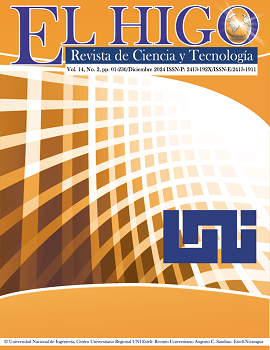Evaluación de alternativas productos químicos, biopreparados orgánicos y botánicos para el control de insectos del suelo en la etapa vegetativa del pimiento dulce (Capsicum Annuum l.)
DOI:
https://doi.org/10.5377/elhigo.v14i2.19683Palabras clave:
Órdenes, control plagas, incidencia, enfermedad, claves dicotómicasResumen
Este estudio se realizó en la Finca Agrícola Experimental de la Universidad Nacional de Ingeniería (FAE-UNI) en Masaya, abarcando una parcela de 435 m². Su objetivo fue evaluar diferentes alternativas químicas, biopreparados orgánicos y tratamientos botánicos en la primera etapa vegetativa del Pimiento Dulce (Capsicum annuum L.) para el control de insectos del suelo. La investigación buscó identificar la opción más efectiva y sostenible para pequeños y medianos productores. Se recolectaron e identificaron 3,557 insectos pertenecientes a 9 órdenes, predominando Hemíptera (1,916 individuos) y Hymenoptera (910). Se registraron 17 familias, siendo las más comunes Pseudococcidae (1,898 individuos), Spirostreptidae (182), Gryllidae (133) y Chrysomelidae (91). También se evaluó el porcentaje de incidencia de enfermedades en el sistema radicular, encontrando necrosis en todos los tratamientos, con un 29% en el tratamiento botánico. La incidencia de Rhizoctonia spp fue baja en todos los tratamientos, destacando el químico con un 71%, mientras que las agallas fueron más frecuentes en el tratamiento químico (38%). Para comparar los resultados, se utilizó el programa estadístico R y la prueba de Tukey. La distribución del experimento (BCA) permitió determinar si las alternativas presentaban efectos significativos en el control de plagas. La alternativa botánica resultó ser la más efectiva para reducir la incidencia de plagas, seguida por el biopreparado orgánico, dado a que los componentes utilizados en la preparación de estos poseen propiedades fungicidas que ayudan a disminuir el efecto de los hongos que provocan dichas enfermedades, mientras que el tratamiento químico mostró menor eficacia.
Descargas
678
Citas
Abaunza, K. M. O. (2021). Estimación de la erosión hídrica para la finca y la erosión potencial del suelo en el agrícola experimental UNI de uso actual, municipio Las Flores, departamento de Masaya. Managua.
Alemán Zeledón, F. (2009). Métodos de control de plagas. 169.
Bayer Vegetables. (s.f.). Nemátodos agalladores.
Cañedo, V., Alfaro, A., & Kroschel, J. (2011). Manejo Integrado de las Plagas de Insectos. MIP, 52.
Centro Nacional de Información y Documentación Agropecuaria [CENIDA]. (2004). Guía MIP en el cultivo de chiltoma, 2004. Manejo integrado de plagas, 32.
Como Sembrar. (2022). Guía completa: como prevenir y tratar la necrosis de las plantas.
CropLife Latin America. (2022). Obtenido de www.croplifela.org/es/agrotecnologias/agroquimicos
Fernández Gayubo, S., & Pujade-Villar, J. (30 de 06 de 2015). Orden Hymenoptera. Diversidad Entomológica, pág. 36.
Goula, M., & Mata, L. (30 de 06 de 2015). Orden Hemíptera. Diversidad Entomológica, pág. 30.
Gutiérrez, A. J; Campos, B. H. 2004. Incidencia de mosca blanca (Bemisia tabaci Genn.) y picudo (Anthonomus eugenii Cano) en cinco genotipos de chile. Tesis. Managua NI. UNA (Universidad Nacional Agraria). 39 p.
Hilje, L; Arboleda, O. 1993. Las moscas blancas (Homóptera: Aleyrodidae) en América Central y el Caribe. CATIE (Centro agronómico tropical de investigación y enseñanza), Turrialba, CR. 67 p.
Instituto Nicaragüense de Tecnología Agropecuaría [INTA]. (2014). Guía Técnica de Chiltoma. Guía Técnica de Chiltoma, 47.
Jiménez Martínez, E. (2009). Manejo integrado de plagas.
Jiménez Martínez, E. (2016). Plagas de cultivo, 240.
Jiménez Martínez, E. (2016). Preparación y usos de Bioplaguicidas para el manejo de plagas y enfermedades agrícolas en Nicaragua. Guía Tecnica, 22.
Jiménez Martínez, E., & Rodriguez Flores, O. (2019). Órdenes de insectos de importancia agricola en Nicaragua. Identificación y diagnóstico, 84.
Morishima, K. (2010). Guía del Manejo Integrado de Plagas (MIP). Guía del Manejo Integrado de Plagas (MIP) para técnicos y productores, 33.
Rikolto. (2019). Produccion de chiltoma Nathalie bajo estructuras protegidas con enfoque en MIC. Proyecto Gestion del conocimiento para la produccion sostenible de hortalizas en Nicaragua, Honduras y Guatemala, 95.
Tencio C, R. (217). Guia De Elaboración y Aplicación De Bioinsumo Para Una Producción Sostenible. 36.
Universidad Nacional Agraria. (abril de 2018).
Vazquez Moreno, L. L. (2010). Boletin Fotosanitario. Manejo de plagas en la agricultura ecológica, 115.
Descargas
Publicado
Cómo citar
Número
Sección
Licencia
Derechos de autor 2024 Universidad Nacional de Ingeniería

Esta obra está bajo una licencia internacional Creative Commons Atribución-NoComercial-SinDerivadas 4.0.
Todo el material publicado en la revista se comparte bajo la Licencia Creative Commons Attribution-NonCommercial-NoDerivatives 4.0., se permite la copia y redistribución del material en cualquier medio o formato siempre y cuando se de crédito de forma explícita a la revista, el autor y la obra, se distribuya de forma gratuita y sin hacer modificaciones al contenido.












